Fentanyl has become one of the most alarming contributors to the opioid crisis. While opioids in general carry serious risks, their potency and the way it is often distributed make them far more dangerous than many drugs in their class.
In this article, we explore the factors that make it especially lethal and why understanding these dangers is critical for prevention and recovery.
Potency and Narrow Safety Margin
Fentanyl is estimated to be 50 to 100 times more potent than morphine and around 50 times stronger than heroin. Even a fraction of a milligram can be enough to cause a fatal overdose. Unlike many other opioids, the margin between a dose that eases pain and one that suppresses breathing is extremely small.
This narrow safety margin means that individuals experimenting with drugs laced with fentanyl are at immediate risk. The unpredictability of potency makes it one of the most lethal substances available on the illicit market, and repeated exposure can quickly progress into opioid use disorder.
For those already caught in this cycle, seeking a structured fentanyl addiction rehab offers a critical step toward stability and long-term recovery.
Rapid Onset and Overdose Risk
Another factor that sets fentanyl apart is how quickly it acts once it enters the body. When ingested, injected, or inhaled, it binds to opioid receptors within seconds, producing a sudden and intense high. At the same time, it suppresses the central nervous system, slowing breathing and heart function much faster than other opioids.
It can also cause seizures in addition to respiratory distress. This rapid onset leaves very little time for intervention if someone begins to overdose. Without immediate medical care, a person can lose consciousness and stop breathing within minutes.
Hidden Presence in Street Drugs
Many overdoses occur not because people intentionally seek fentanyl, but because it is often mixed into other substances. Dealers frequently add it to heroin, cocaine, methamphetamine, or counterfeit prescription pills to increase potency and profits. Users are rarely aware of how much is present or that it is there at all.
This hidden presence means that a single pill or a small amount of powder can unexpectedly result in death. Contamination has dramatically increased overdose rates across the nation, creating a public health crisis that reaches individuals in every community.
Accelerated Dependence and Brain Effects
Like other opioids, this drug alters the brain’s reward system by flooding it with dopamine. Because of its strength, these changes occur more quickly and with greater intensity than with most other opioids. Dependence develops rapidly, and the euphoric effects wear off quickly, leading individuals to use more frequently to avoid withdrawal.
This repeated cycle causes tolerance to build fast, pushing people toward increasingly dangerous doses. Long-term use can impair memory, affect emotional regulation, and disrupt decision-making abilities. Similar risks exist with other addictive prescription medications, but the drug’s potency makes its impact even more severe.

Community Impact and Public Health Challenges
Beyond individual risks, this drug has placed an enormous burden on healthcare systems and communities. Emergency rooms are overwhelmed with overdose cases, and first responders often require multiple doses of naloxone to reverse its effects. According to the CDC, synthetic opioids contribute to nearly 70% of overdose deaths in the U.S., with illicitly manufactured fentanyl (IMF) being a major driver.
The financial and emotional strain reaches families, schools, and workplaces, making the crisis not only a personal tragedy but a public health emergency that affects every layer of society.
Why Education and Treatment Matter
Recognizing why fentanyl is more dangerous than other opioids is key to prevention. Education about its potency, the risk of hidden contamination, and the speed of overdose can help individuals make safer choices and identify warning signs early.
Entering a comprehensive addiction rehab program is also essential in breaking the cycle of dependence. Effective care often combines medical guidance, behavioral therapy, and ongoing care to address both physical dependence and psychological struggles. For families, awareness of these dangers encourages early action and the pursuit of professional help before tragedy occurs.
Final Thoughts from Northwoods Haven Recovery
Fentanyl is more dangerous than other opioids because of its extreme potency, rapid effects, and high risk of hidden contamination. These factors create a deadly combination that makes overdose more likely and recovery more complicated. Understanding these risks is the first step in protecting individuals and communities.
At Northwoods Haven Recovery, we provide evidence-based care for individuals struggling with opioids. Our outpatient programs in Minneapolis, MN, address both physical dependence and the underlying emotional challenges of addiction, offering a structured path to recovery. With clinical expertise and compassionate support, we help clients and families move forward toward safer, healthier lives.


